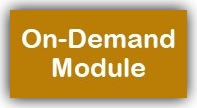ASPAN Learn
Catalog Advanced Search
-
Safety as a priority in the perianesthesia setting. Module will be available for 120 days from date of purchase.
This module will present safety as a priority in the perianesthesia setting.

Linda Beagley
MS RN CPAN FASPAN
-
You must log in to register
- Non-member - $40
- Member - $15
- More Information
-
You must log in to register
-
Care of the pregnant patient in PACU. Module will be available for 120 days from date of purchase.
This session will present care of the pregnant patient in PACU.

Linda Beagley
MS RN CPAN FASPAN
-
You must log in to register
- Non-member - $40
- Member - $15
- More Information
-
You must log in to register
-
Discuss priorities for the perianesthesia nurse when caring for the ECT patient. Module will be available for 120 days from date of purchase.
This module will discuss priorities for the perianesthesia nurse when caring for the ECT patient.

Nancy O’Malley
MA BSN RN CPAN(Ret) CAPA(Ret) FASPAN
-
You must log in to register
- Non-member - $40
- Member - $15
- More Information
-
You must log in to register
-
To enable the nurse to increase knowledge on healthy workplace strategies. Module will be available for 120 days from the date of purchase.
Target Audience: All perianesthesia nurses
Outcome: To enable the nurse to increase knowledge on healthy workplace strategies
Case Presentations: Any case studies discussed during the program are fictional and do not reflect any real persons or events
Requirements for successful completion: You must complete the module in its entirety, achieve 100% n the posttest, and complete the online evaluation by the deadline to receive contact hour credit.
Contact Hour: 1.0
Valid: 6/30/23 - 6/30/25 Activity Content Expiration Date: 06/30/25


Stacy Apodaca
MSN RN PMH-BC
-
You must log in to register
- Non-member - $40
- Member - Free!
- More Information
-
You must log in to register
-
To enable the nurse to increase knowledge on healthy workplace strategies. Module will be available for 120 days from the date of purchase.
Target Audience: All perianesthesia nurses
Outcome: To enable the nurse to increase knowledge on healthy workplace strategies
Case Presentations: Any case studies discussed during the program are fictional and do not reflect any real persons or events
Requirements for successful completion: You must complete the module in its entirety, achieve 100% n the posttest, and complete the online evaluation by the deadline to receive contact hour credit.
Contact Hour: 1.0
Valid: 6/30/23 - 6/30/25 Activity Content Expiration Date: 06/30/25


Connie Hardy Tabet
MSN RN CPAN CAPA FASPAN
-
You must log in to register
- Non-member - $40
- Member - Free!
- More Information
-
You must log in to register
-
To enable the nurse to increase knowledge on healthy workplace strategies. Module will be available for 120 days from the date of purchase.
Target Audience: All perianesthesia nurses
Outcome: To enable the nurse to increase knowledge on healthy workplace strategies
Case Presentations: Any case studies discussed during the program are fictional and do not reflect any real persons or events
Requirements for successful completion: You must complete the module in its entirety, achieve 100% n the posttest, and complete the online evaluation by the deadline to receive contact hour credit.
Contact Hour: 1.0
Valid: 6/30/23 - 6/30/25 Activity Content Expiration Date: 06/30/25


Elizabeth Card
DNP APRN FNP-BC CPAN CCRP FAAN FASPAN

Myrna Mamaril
DNP RN NEA-BC CPAN CAPA FAAN FASPAN
-
You must log in to register
- Non-member - $40
- Member - Free!
- More Information
-
You must log in to register
-
To enable the nurse to increase knowledge on healthy workplace strategies. Module will be available for 120 days from the date of purchase.
Target Audience: All perianesthesia nurses
Outcome: To enable the nurse to increase knowledge on healthy workplace strategies
Case Presentations: Any case studies discussed during the program are fictional and do not reflect any real persons or events
Requirements for successful completion: You must complete the module in its entirety, achieve 100% n the posttest, and complete the online evaluation by the deadline to receive contact hour credit.
Contact Hour: 1.0
Valid: 6/30/23 - 6/30/25 Activity Content Expiration Date: 06/30/25


Alphonzo Baker Sr
DNP RN CAPA FASPAN
-
You must log in to register
- Non-member - $40
- Member - Free!
- More Information
-
You must log in to register
-
To enable the nurse to increase knowledge on healthy workplace strategies. Module will be available for 120 days from the date of purchase.
Target Audience: All perianesthesia nurses
Outcome: To enable the nurse to increase knowledge on healthy workplace strategies
Case Presentations: Any case studies discussed during the program are fictional and do not reflect any real persons or events
Requirements for successful completion: You must complete the module in its entirety, achieve 100% n the posttest, and complete the online evaluation by the deadline to receive contact hour credit.
Contact Hour: 1.0
Valid: 6/30/23 - 6/30/25 Activity Content Expiration Date: 06/30/25


Re'Shonda Smith
DNP APRN CRNA
-
You must log in to register
- Non-member - $40
- Member - Free!
- More Information
-
You must log in to register
-
Adverse surgical events cause negative patient health outcomes and harm that can often overshadow the safe and effective patient care provided daily by nurses as members of interprofessional healthcare teams. The purpose of this manuscript is to educate, inform, and stimulate critical thinking by discussing perioperative near miss case studies and the underlying factors that lead to errors.
Authors: Christopher H. Stucky, PhD, RN, CNOR, CSSM, CNAMB, NEA-BC, FAAN, J. Michael Hartmann, DNP, RN, CNOR, CSSM, CNAMB, RNFA, Young J. Yauger, PhD, RN, CRNA, Kenneth J. Romito, DNP, RN, APRN, AGCNS-BC, CNOR, CSSM, David F. Bradley, DNP, RN, APRN, AGCNS-BC, CNOR, Gaston Baza, DNP, RN, CNOR, Megan E. Lorenz, DNP, RN, APRN, ACCNS-AG, AGACNP-BC, RN-BC, Sherita L. House, PhD, RN, CCRN, Rebeccah A. Dindinger, DNP, RN, RNC-OB, IBCLC, Joshua A. Wymer, DNP, RN, CNOR, RN-BC, NEA-BC, CHCIO, CDH-E, FACHE, FAAN, Melissa J. Miller, PhD, RN, CNOR, Albert R. Knight, DNP, RN, CNS-CP, CNOR
Adverse surgical events cause negative patient health outcomes and harm that can often overshadow the safe and effective patient care provided daily by nurses as members of interprofessional healthcare teams. Near misses occur far more frequently than adverse events and are less visible to nurse leaders because patient harm is avoided due to chance, prevention, or mitigation. However, near misses have comparable root causes to adverse events and exhibit the same underlying patterns of failure. Reviewing near misses provides nurses with learning opportunities to identify patient care weaknesses and build appropriate solutions to enhance care. As the operating room is one of the most complex work settings in healthcare, identifying potential weaknesses or sources for errors is vital to reduce healthcare-associated risks for patients and staff. The purpose of this manuscript is to educate, inform, and stimulate critical thinking by discussing perioperative near miss case studies and the underlying factors that lead to errors. Our authors discuss 15 near miss case studies occurring across the perioperative patient experience of care and discuss barriers to near miss reporting. Nurse leaders can use our case studies to stimulate discussion among perioperative and perianesthesia nurses in their hospitals to inform comprehensive risk reduction programs.-
You must log in to register
- Non-member - $15
- Member - Free!
- More Information
-
You must log in to register
-
Multisystem inflammatory syndrome in children (MIS-C) is an immune response inciting multiorgan dysfunction and a shock-like state which is typically seen in children 2 to 6 weeks after either a coronavirus disease-19 infection or exposure. This article puts forward challenges and clinical dilemmas faced during the anesthetic management of three children with MIS-C presenting for emergency and elective surgery.
Authors: Geeta kamal, MDa, Swetha Rudravarama, Shilpa Agarwal, MDa, Anju Gupta, MD, DNB, IDRA, EDRA
Multisystem inflammatory syndrome in children (MIS-C) is an immune response inciting multiorgan dysfunction and a shock-like state which is typically seen in children 2 to 6 weeks after either a coronavirus disease-19 infection or exposure. When such a child comes for any surgery, perioperative anesthetic management demands multidisciplinary involvement and individualized case-based decision-making. Due to the novelty of the condition, there are limited data on anesthetic implications in these patients. Anesthetic management in the affected children is dynamic depending on the organ systems involved and the progression of the disease state. Though the long-term effects of the syndrome are largely unknown, we hope that awareness of the MIS-C-associated complications may help anesthesiologists involved in childcare. Herein, we put forward challenges and clinical dilemmas we faced during the anesthetic management of three children with MIS-C presenting for emergency and elective surgery.-
You must log in to register
- Non-member - $15
- Member - Free!
- More Information
-
You must log in to register


